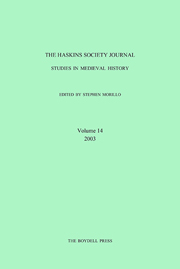Book contents
- Frontmatter
- Contents
- List of Illustrations
- Editorial Note
- Abbreviations
- 1 Even the Devil (Sometimes) has Feelings: Emotional Communities in the Early Middle Ages
- 2 Alcuin, Willibrord, and the Cultivation of Faith
- 3 Henry Loyn Memorial Lecture: English Identity from Bede to the Millennium
- 4 The ‘Farm of One Night’ and the Organisation of Royal Estates in Late Anglo-Saxon Wessex
- 5 Changing Fortunes: Edwardian Anglo-Jewry and their Credit Operations in Late Thirteenth-Century England
- 6 Forty Acres and a Mule: the Mechanics of English Settlement in Northeast Wales after the Edwardian Conquest
- 7 Consanguinity and the Saint-Aubin Genealogies
- 8 Widows, Religious Patronage and Family Identity: Some Cases from Twelfth-Century Yorkshire
- 9 Desecration and Consecration in Norman Capua, 1062–1122: Contesting Sacred Space during the Gregorian Reforms
- 10 From Ego to Imago: Mediation and Agency in Medieval France (1000–1250)
7 - Consanguinity and the Saint-Aubin Genealogies
Published online by Cambridge University Press: 05 September 2014
- Frontmatter
- Contents
- List of Illustrations
- Editorial Note
- Abbreviations
- 1 Even the Devil (Sometimes) has Feelings: Emotional Communities in the Early Middle Ages
- 2 Alcuin, Willibrord, and the Cultivation of Faith
- 3 Henry Loyn Memorial Lecture: English Identity from Bede to the Millennium
- 4 The ‘Farm of One Night’ and the Organisation of Royal Estates in Late Anglo-Saxon Wessex
- 5 Changing Fortunes: Edwardian Anglo-Jewry and their Credit Operations in Late Thirteenth-Century England
- 6 Forty Acres and a Mule: the Mechanics of English Settlement in Northeast Wales after the Edwardian Conquest
- 7 Consanguinity and the Saint-Aubin Genealogies
- 8 Widows, Religious Patronage and Family Identity: Some Cases from Twelfth-Century Yorkshire
- 9 Desecration and Consecration in Norman Capua, 1062–1122: Contesting Sacred Space during the Gregorian Reforms
- 10 From Ego to Imago: Mediation and Agency in Medieval France (1000–1250)
Summary
Around the turn of the century, René Poupardin, working in the Vatican archives, came across a page of a manuscript in the collection of Queen Christina which contained several genealogies pertaining to the counts and dukes of north-western France. An incomplete note at the bottom of the manuscript page indicates that it was drawn up at the monastery of Saint-Aubin d'Angers. This page was bound together with a wide variety of other documents, ranging from astrological tracts to letters to fragments of various histories. On paleographic grounds, the manuscript page with the genealogies can be dated to the eleventh century, but it does not appear to have any connection with the other documents bound in the manuscript. In 1900 Poupardin published the genealogies with a brief commentary.
In that commentary, Poupardin made a tentative assessment of the page, and came to two conclusions. First, he assigned to this document a date between 1066 and 1080. Second, he concluded that the genealogies had been drawn up ‘at the moment when the two sons of the Count of Château-Landon, Geoffrey the Bearded and Fulk le Réchin, succeeded their maternal uncle, Geoffrey Martel, the last of the Ingelgerien dynasty, in the County of Anjou.’ He was suggesting that the purpose of these genealogies was to demonstrate how the new dynasty of Angevin counts was connected with the previous dynasty, as well as with various neighboring ruling families.
- Type
- Chapter
- Information
- The Haskins Society Journal 142003. Studies in Medieval History, pp. 105 - 116Publisher: Boydell & BrewerPrint publication year: 2005



